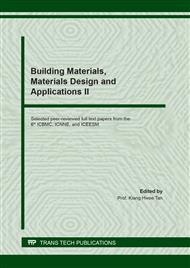[1]
Papo, L.Pain:Cem.Concr.Res.34,2097,(2004).
Google Scholar
[2]
Japan society of civil engineers: 2012 Established Concrete Standard Specification [Construction], (2012).
Google Scholar
[3]
M. Inaba, K. Maruyama, S. Minaguchi, N. Sakata: Flowability Keeping. Mechanism of Self-Compacting Concrete, Vol.18, No.1, pp.129-134, 1996(Japanese).
Google Scholar
[4]
T. Sugamata, A. Hibino, M. Ouchi, H. Okamura: Effects of the molecular structure of polycarboxylate polymers on the cement particle dispersibility, Journal of JSCE, V-49, No.662, pp.17-27, 2000(Japanse).
DOI: 10.2208/jscej.2000.662_17
Google Scholar
[5]
A. Ohta, T. Sugiyama, Y. Tanaka: Fluidizing Mechanism and Application of Polycarboxylate-Based Superplasticizers, 5th CANMET/ACI International Conference on Superplasticizers and Other Chemical Admixtures in Concrete, pp.359-378, (1997).
DOI: 10.14359/6193
Google Scholar
[6]
T. Haga, S. Aoki, N. Miura, R. Chikamatsu: Basic research on ultra-high strength underground continuous wall concrete, The 46th Annual Scientific Lecture Meeting of the Japan Society of Civil Engineers, V, pp.648-649, 1999(Japanese).
Google Scholar
[7]
A. Ohta, K. Uomoto: Fundamental study on the chemical structures of advanced superplasticizers and their effect on flowability. (1), SEISAN KENKYU, Vol.49, No.12, pp.637-640, 1997(Japanese).
Google Scholar
[8]
R.J. Flatt, J.Zimmermann, Cc.Hampel, C.Kurz, I.Schober, L.Frunz, C. Plassard, and E. Lesniewska: The role of adsorption energy in the sulfate–polycarboxylate competition, ACI International Conference, Vol.262, pp.153-164, (2009).
Google Scholar
[9]
Q. Ran, P. Somasundaran, C. Miao, J. Liu, S. Wu, J.and Shen: Effect of the length of the side chains of comb-like copolymer dispersants on dispersion and rheological properties of concentrated cement suspensions, Journal of Colloid and Interface Science 2009; 336: 2624-633, (2009).
DOI: 10.1016/j.jcis.2009.04.057
Google Scholar
[10]
A. Ohta, K. Uomoto: Dispersing Effect of Polycarboxylate-Based Superplasticizers for Binder Particles, Proceedings of the Japan Concrete Institute, Vol.20, No.2, pp.85-90, 1998(Japanese).
Google Scholar
[11]
D. Hamada, T. Sato, F. Yomoto, T. Mizunuma: Development of new superplasticizer and its application to self-compacting concrete, Proceedings of the 6th CANMET/ACI International Conference on Superplasticizers and Other Chemical Admixtures in Concrete, 211. Ed. V.M. Malhotra, American Concrete Institute; SP-195-17, pp.269-290, (2000).
DOI: 10.14359/9918
Google Scholar
[12]
K.Yamada, S. Ogawa, and S.Hanehara: Controlling of the adsorption and dispersing force of polycarboxylate-type superplasticizer by sulfate ion concentration in aqueous phase, Cem Concr Res , 31, 3, pp.375-383, (2001).
DOI: 10.1016/s0008-8846(00)00503-2
Google Scholar
[13]
H.H Bache: Densified cement-based ultrafine particle-based material, Proceedings of the 2th International Conference on Superplasticizer in Concrete, Ottawa; pp.185-213,(1981).
Google Scholar
[14]
K. Maeda, M. Ouchi: Maintaining fluidity of self-filling mortar in a high-temperature environment, Proceedings of the Japan Concrete Institute, Vol.31, No.1, pp.1465-1470, 2009(Japanese).
Google Scholar
[15]
M. Takigawa, R. Faraidoon, R. Kit, S. Date: Basic Research of Improving the Mortar Flow by Thermal Stimulation to Superplasticizer, MATEC Web of Conferences, 278, 01003, pp.1-6, (2018).
DOI: 10.1051/matecconf/201927801003
Google Scholar
[16]
M. Takigawa, K. Sasaki, R. Kita, S. Date: Thermal stimulation effect on superplasticizers on the fresh properties of mortar, Proceedings of the Japan Concrete Institute, Vol.41, No.1, pp.1139-1144, 2019(Japanese).
Google Scholar
[17]
M. Takigawa, Y. Bomura, S. Hashimoto, S. Date: Effect of Thermal Stimulation on Various Characteristics of Superplasticizer, International Journal of Engineering and Technology, Vol.11, No.4, pp.262-266, (2019).
DOI: 10.7763/ijet.2019.v11.1158
Google Scholar
[18]
Y. Takashima: Chapter 2 Uranium enrichment, The Journal of the Institute of Electrical Engineers of Japan, Vol.92, No.5, pp.518-522, 1972(Japanese).
Google Scholar
[19]
Y. Moriya, A. Ohta: The Trend of Air Entraining and High Range Water Reducing Agent, Journal of the Society of Materials Science, Japan, Vol.43, No.491, pp.919-929, 1994(Japanese).
DOI: 10.2472/jsms.43.919
Google Scholar


